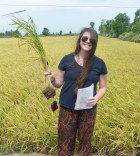Conforming to Climate Change
 Vietnam is the second largest rice exporter in the world.
Vietnam is the second largest rice exporter in the world.  The Mekong Delta produces over 50% of the country’s rice, and represents about 90% of the rice export. The delta is ideal for rice production because of its low, flat wetlands; although this environment is beneficial for rice production, it puts natives of the delta, and their crops, in danger as the climate changes and sea levels rise.
The Mekong Delta produces over 50% of the country’s rice, and represents about 90% of the rice export. The delta is ideal for rice production because of its low, flat wetlands; although this environment is beneficial for rice production, it puts natives of the delta, and their crops, in danger as the climate changes and sea levels rise.
Salinity intrusion and sea level rise are threatening Vietnam’s agrarian based economy. Over 54% of the labor force works  in agriculture, and the Mekong Delta will be one of the worst regions hit by climate change in the world. The wet season is getting wetter and the dry season is getting drier. Increased flooding during the wet season causes erosion of riverbanks and coastal areas, as well as drowning of many crops.
in agriculture, and the Mekong Delta will be one of the worst regions hit by climate change in the world. The wet season is getting wetter and the dry season is getting drier. Increased flooding during the wet season causes erosion of riverbanks and coastal areas, as well as drowning of many crops.  In the dry season, however, water levels are very low with low upstream flow, causing salt-water
In the dry season, however, water levels are very low with low upstream flow, causing salt-water  intrusion from the sea to coastal wetland areas. During the dry season, saltwater seeps inland into rivers and groundwater. Depending on topography and variable climate, the inundation period can last anywhere from 2-6 months, wreaking havoc on those living in the area. Rice and other crops cannot grow with such high salt concentration in the water, and in 2010 the saline inundation reached 70km inland all the way to Can Tho.
intrusion from the sea to coastal wetland areas. During the dry season, saltwater seeps inland into rivers and groundwater. Depending on topography and variable climate, the inundation period can last anywhere from 2-6 months, wreaking havoc on those living in the area. Rice and other crops cannot grow with such high salt concentration in the water, and in 2010 the saline inundation reached 70km inland all the way to Can Tho.
Researchers at Can Tho University and The Bac Lieu Center of Seed Supply are working to find strains of rice that can adapt to these changing conditions.  By using specific trait selection and analyzing genetics, they are attempting to alter local strains of rice; the goal is for the rice to be able to survive fully submerged and still produce a high yield and quality product. They are also experimenting with saline tolerant rice. Already, researchers have developed saline tolerant rice up to 5PPT.
By using specific trait selection and analyzing genetics, they are attempting to alter local strains of rice; the goal is for the rice to be able to survive fully submerged and still produce a high yield and quality product. They are also experimenting with saline tolerant rice. Already, researchers have developed saline tolerant rice up to 5PPT.
 We recently visited a farmer who partnered with CTU and dedicated a plot of agricultural land to rice research. Students and researchers split the plot into many small plots, each with a different set of variables: variety, plowing, lime, and
We recently visited a farmer who partnered with CTU and dedicated a plot of agricultural land to rice research. Students and researchers split the plot into many small plots, each with a different set of variables: variety, plowing, lime, and  leaching/washing. It was interesting to see how these different combinations of variables impacted the health of the rice.
leaching/washing. It was interesting to see how these different combinations of variables impacted the health of the rice.
The greatest obstacle is finding a strain of rice that can both survive in these harsh conditions and yield a high quality product.  The quality of the rice is very important because the government sets standards for companies that sell rice, and without a government certificate of approval the rice cannot be exported.
The quality of the rice is very important because the government sets standards for companies that sell rice, and without a government certificate of approval the rice cannot be exported.
Many farmers have resorted to integrated farming in order to adjust to the new climate. In the dry season, they grow shrimp in the brackish water, and in the wet season they grow rice. We visited several farms like this, and although the system is working well now, these farms will eventually need rice that is tolerant to salinity or submergence.
 Climate change is inevitable, and in order to survive the new weather extremes and saltwater inundation the people will have to prepare and adapt. From the types of farming to the crops, the only option is to conform to the new reality.
Climate change is inevitable, and in order to survive the new weather extremes and saltwater inundation the people will have to prepare and adapt. From the types of farming to the crops, the only option is to conform to the new reality.


Leave a comment